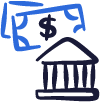How To Manage Personal Finances
- Evaluate your current financial situation
- Set clear, achievable financial goals
- Develop and maintain a realistic budget
- Avoid high-interest credit options, such as credit cards and payday loans
- Build an emergency fund to handle unexpected expenses
If your idea of applying discipline to your personal finances is restraining you from spending your entire paycheck in the first 24-hour period after you receive it, you’re not alone. As of August 2023, as much as 61% of Americans report living paycheck to paycheck, a staggering number.
A culture of instant gratification characterized by ever-more-extravagant status symbols pervades the Western world these days, having a firm grip on both rich people who can afford its trappings and regular folks who can’t keep up with the Joneses without throwing themselves into a dire financial situation.
Free Consultation with a Certified Debt Specialist
Start with a Free No-Obligation Consultation
If your idea of applying discipline to your personal finances is restraining you from spending your entire paycheck in the first 24-hour period after you receive it, you’re not alone. As of August 2023, as much as 61% of Americans report living paycheck to paycheck, a staggering number.
A culture of instant gratification characterized by ever-more-extravagant status symbols pervades the Western world these days, having a firm grip on both rich people who can afford its trappings and regular folks who can’t keep up with the Joneses without throwing themselves into a dire financial situation.

See if National Debt Relief can help!
Take Back Control
Unfortunately, most people fall into the latter group of regular folks who cannot keep up with buying the new iPhone, flashiest car, or pair of Nikes every single time one drops. Still, whether you’re surviving comfortably or struggling to make ends meet from month to month, trying to impress others with all your cool gadgets while simultaneously ruining your financial situation is not a sustainable strategy for living a happy life.
Luckily, the financial stress often associated with keeping up with the Joneses is avoidable, if you know how to manage your personal finances. Below we go into how to get a firm grip on your financial situation, as well as telling you about the types of credit to avoid at all costs. Let’s take back control together.
Take a detailed, no-holds-barred look at your current financial situation
Short of winning the lottery or finding an unclaimed bag of unmarked bills, you won’t be able to quadruple your income, fully pay down your debts, or buy your dream house overnight. However, what you can do is reorder how you look at your personal finances and begin making smart decisions with an eye to where you’d like yourself and your family to be 5 to 10 years down the road.
The first step on your personal finance journey and thereby improving your financial situation is a detailed, no-holds-barred look at your current position. As the old saying goes, you can’t manage what you don’t measure.
To get a good grasp of where you’re currently standing financially, you’ll need to determine accurate values for some key financial data points before you proceed. First up, your income. Figure out exactly how much you earn, after taxes, from your primary employer as well as any part-time or freelance work you may do on the side. Be sure to add any income from savings accounts, CDs or investments that you don’t plan to reinvest.
Then, assess how much money you have left after you’ve paid all your recurring expenses. In this bucket will fall your rent or monthly mortgage payment, monthly debt repayments, utilities bill, gas, groceries, and anything else you pay each month. If you deduct all your recurring expenses from your income, you’ll be left with the amount of money you have left to spend on non-recurring expenses such as holidays, down payments on your debt, or anything else that comes to mind.
Next up: your debt situation. Sure, it may be painful, but you must determine the exact principal amount of all of your outstanding credit card balances, medical bills, and loans, including your mortgage and car note. For the purposes of this exercise, don’t worry about how much of your take-home pay has gone toward interest payments over the years. Unfortunately, that’s money that you can’t get back.
Once you have an exact snapshot of how much you owe excluding interest, you’ll need to determine the average rate of growth of your debt, a figure that can vary tremendously depending on your unique mix of debtors. If your household’s only major liabilities are a mortgage and a car loan, which you’re likely paying down little by little each month, your debt’s growth rate may be negative. On the other hand, if you’re in the habit of carrying high credit card balances and making little more than the minimum payment each month, your debt may be growing at an alarming rate. The single most important thing to do during this exercise is for you to be honest. It’s better to precisely know your debt growth rate even if it’s an alarming figure, because knowing this allows you to do something about it.
Set goals taking your current situation into account
After you’re crystal clear on your financial situation, it’s time to make a plan forward. To make a plan, you first need to think about where you want to be in 5 to 10 years. If there’s a goal, you have something specific to work towards.
If you’re currently in a financially dire situation, your 5-year goal may be to be debt-free. However, if your situation is already fine, your goal may be to have $50,000 saved up in 5 years’ time. Whatever your goal may be, write it down as specific as possible. This makes it tangible.
- Make a plan to get to your goal
Now that you have your goals written down, let’s make a plan to get there in due time. If you’re in a financially healthy situation and your goal is to save and/or invest, a calculator like this can help you build a plan. Plug in your starting amount, time horizon, your expected rate of return (interest rate on savings and/or average return on investments), and you’ll see how much you have to save and/or invest to get to your desired ending balance.
However, if you’re in debt right now, the next step should be to get rid of that. You can avoid many problems caused by the excessive use of credit if you don’t need to borrow money in the first place, so it’s crucial to stick to a budget and spend less than what you earn.
Making a rudimentary personal budget is quite straightforward: in addition to determining values for your monthly income and debt obligations, figure out how much you currently spend on bills, food, fuel, and anything else you might need in a typical month. This is what we’ve done in step 1 already, so you have this data ready to rock. If your expenditures approach or exceed the difference between your income and your monthly debt payments, some adjustment is in order.
Fortunately, it’s simple to right-size the cost of running your household. (And yes, we know, simple may not mean easy.) Avoid making fun but expensive purchases, like fancy restaurant dinners for minor celebrations or Saturday afternoon trips to the ballpark with your kids and their friends, that may not be worth the financial stress in the long-run. Try to eat home-cooked meals, using frozen bags of pre-cut veggies and 80-20 chuck instead of fresh arugula and grass-fed steaks. Cut out the subscriptions you don’t even use that often, you probably don’t watch Disney+, Netflix, Amazon Prime, HBO Max and Youtube Premium every single day anyway. The cost-cutting potential of a well-thought-out budget is virtually limitless. After you’ve undertaken this exercise, you probably find yourself in a spot where your income exceeds your expenses, meaning you’re able to start nibbling away at the ever-growing mountain of debt.
You’ll find it easier to get a handle on your personal finances if your debt is shrinking. To that end, stop using your credit cards to make new purchases and start paying down your high-interest balances to avoid wasting more money than you have to on interest charges. Sure, this may be a hard thing to do, even more so if you’re carrying a balance month to month, but this is the single most important thing you can do. Resist attractive “introductory” credit card offers that promise a zero cost of borrowing for months or years and “low rates” after that, using debit cards or cash instead.
Avoid these types of credit at all costs
Once you’ve gotten your debt situation under control, using a low-priced debt settlement service if necessary, make sure to avoid the mistakes that got you into this dire situation in the first place. Fair enough, not all credit is harmful: you probably wouldn’t be able to afford your home or car without a sizable loan after all. However, if you’re serious about managing your personal finances, there are a few types of credit that you should avoid in all but the most dire circumstances.
Credit cards are useful until the first time that you fail to pay off your balance in full at the end of your monthly grace period. As of November 2023, the average credit card interest is 24.56%. Carrying a balance for even a single month has the potential to throw you into the vicious cycle of credit card debt. Additionally, carrying a balance for even as little as one month negates the value of any rewards or cash bonuses that you may earn by using your card frequently, and missing just one payment will incur late charges and a penalty APR that can approach 30 percent.
Most financially responsible folks carry one or two credit cards in their wallets for use only in serious emergencies, like an unforeseen car repair that’s not covered by the vehicle’s warranty. Otherwise, there’s no point in tempting fate by racking up credit card charges that you can afford to pay for out-of-pocket.
Bonus tip: build up an emergency fund. To ensure that you’re able to make these emergency purchases, set up a savings account, drop five or 10 percent of each paycheck into it, and don’t touch it except to pay off your credit card. Building up your emergency fund gives you the peace of mind that you can pay for anything unexpected life might throw your way. And you’ll simultaneously earn interest on your emergency fund – that’s a win-win!
As bad as credit cards can be, some forms of credit are even worse. Payday loans come with ruinous interest charges that exceed those of even the worst credit cards by an order of magnitude. Since most payday borrowers have poor or nonexistent credit ratings and thus few other credit options, payday lenders can get away with charging 15 percent of the loan’s total value just for the privilege of taking it out.
Since they’re designed for a very short term, usually not more than two weeks, the full cost of payday loans is lost on borrowers who just need them to get by until their next paycheck comes through. Expressed as an APR, however, that same 15 percent charge balloons to nearly 400 percent. In fact, many states still permit payday loans to be rolled over indefinitely, trapping unwitting borrowers in death spirals of debt from which it’s difficult to recover.
Building toward a financially healthy future
Managing your personal finances requires initial sacrifice and ongoing discipline, but it’s bound to pay off in the long run if you make a plan and stick to it. Start by taking a cold hard look at your current financial situation. Be honest about it. When you know where you stand financially, write down your 5- or 10-year goal. With these goals in mind, you’ll be able to devise a plan to get there. The single most important thing you can do to manage your personal finances and make sure you’ll get to your goal in due time is to create a budget and stick to it.
If you have high-interest debt, your priority should be to get rid of that first. If you’re overwhelmed by this thought, we can help you get rid of your debt, while paying significantly less than you owe. Check out how it works here! To not let the situation get out of control any further, we’ve gone over the types of credit to avoid at all costs. With the steps and additional information provided in this article, we hope that you can get your personal finances under control in due time. Once your debt situation and household budget are under control, you’ll be able to begin saving in earnest for a future that you never dreamed would come to pass.
All You Need To Know
We’ve put all of our essential resources in one spot. Everything from debt resolution to taking control of your financial future . Need to talk? Our experts are here to help. Call us anytime for a free no-obligation consultation.
Pay off your credit card debt
- Receive A Free Savings Estimate Today
- See How Quickly You Can Be Debt Free
- No Fees Until Your Accounts Are Settled
Essential Reading
The latest debt relief news, tips, and resources from our team.
We’ve transformed the lives of more than 500,000 people

“The anxiety is gone, I am credit card debt-free. And that right there, I never thought I would be able to say those words, and it just feels so good.”
Michelle saved 23% on her debt

Now I’m able to go on vacation for the first time in a long time- I was able to go and relax. I couldn’t do that before.

Now I wake up knowing that I am paying off my debt, it’s like a weight lifted off my chest and I can breathe a bit more.

“The anxiety is gone, I am credit card debt-free. And that right there, I never thought I would be able to say those words, and it just feels so good.”
Michelle saved 23% on her debt

Now I’m able to go on vacation for the first time in a long time- I was able to go and relax. I couldn’t do that before.

Now I wake up knowing that I am paying off my debt, it’s like a weight lifted off my chest and I can breathe a bit more.

“The anxiety is gone, I am credit card debt-free. And that right there, I never thought I would be able to say those words, and it just feels so good.”
Michelle saved 23% on her debt

Now I’m able to go on vacation for the first time in a long time- I was able to go and relax. I couldn’t do that before.







